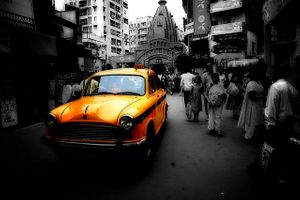With its 1950s style, a slightly-curved look and a sturdy frame, its faulty brakes, and the old diesel engine, the Hindustan Ambassador may hardly seem an attractive car for the millennial generation. The vehicle was produced in India for decades and had once been a symbol of status. The discontinuation of its production in 2014 ushered in the feeling of nostalgia and served as one more reminder that nothing is eternal, even in India. The recently announced purchase of the brand by the French automotive company Peugeot may deepen these feelings for some or rekindle a small flame of hope for others.
The company that produced the Ambassador, Hindustan Motors, was established in 1942, five years prior to India’s independence. Both in the last moments of the British empire as well as for decades after the colonial power had left India, many cars produced by Hindustan Motors were modeled on British vehicles. The most iconic Hindustan Ambassador model was fashioned after the Morris Oxford III, a British car, and manufacturing started in late 1950, more than 10 years after the empire had left. It was, for a long time, the prime choice of vehicle for India’s politicians and civil servants. The cavalcades of white Ambassador cars plying the wide avenues of New Delhi, the seat of India’s government, are as symbolic a sight for millions of Indians as black limousines are for Americans. Thus, the Ambassador was indicative of many symbols of India’s dual approach to the colonial legacy: a British-modeled vehicle represented political status in postcolonial India.
The Ambassador was just as iconic for foreign tourists. It served as a taxi in many Indian cities, including New Delhi where it donned black and orange colors. Taxis themselves had long been (and largely still remain) a symbol of material status in India. Sitting in an Ambassador car that was both an expensive ride and was nearly identical to the government vehicles thus evoked dual symbolism. A foreign tourist sitting in an Ambassador car could think of himself as a sahib (‘master’) – for good or for bad, depending on one’s own views and interpretation of the word. Back in 2013, the Top Gear show even named the Ambassador the world’s best taxi. Thus, the car has been India’s ‘brand Ambassador’ in more than one way.
These image-related issues cannot, however, hide the fact that the Ambassador was plagued with technical snags and had fallen out-of-step with progress decades ago. The 1980s might have been the last decade of the Ambassador’s reign. Not only was the car old by then but the government was gradually opening itself to foreign companies, doing away with monopolies, following the colossal failure of the Maruti car. The Maruti, a government project in the 1970s, contrary to the luxurious Ambassador, was portrayed as the everyman’s car. The Indian government passed the project to Suzuki after the company won an open bid. The Japanese company had not only commenced the production of the Suzuki Maruti but once it established itself a foothold, threatened the Ambassador’s production. At the beginning of 1990s, India liberalized its economy to a large degree and a number of international car companies entered the market, introducing much more diversity to Indian roads.
The current government of India is sure to capitalize on the Ambassador’s takeover by Peugeot as a success of its present economic strategy. The prime minister of India, Narendra Modi, claims that he will reinforce the Indian economy with a “Make in India” campaign that focuses on attracting foreign direct investment in heavy industry. The paltry sum of 800 million rupees ($12 million) that Peugeot paid for the Ambassador brand is indicative of the product’s inevitable down-pricing but the reported total investment of the French company in the CK Birla group (that until now owned Ambassador’s production), which is supposed to stand at 7 billion rupees ($105 million), may sound more promising. Peugeot, having so far had mixed experiences in India, aims at producing new cars in the coming year.
Thus, when the Ambassador was discontinued in 2014 and then sold to a foreign company in 2017, it may be considered as one more symbol: the passing of the era of socialist production in India, a one of government monopolies and control over foreign capital but also a one of production monotony and of backlogs in technical innovation, and the gradual coming of the capitalist era when foreign capital, once considered dangerous by the socialist elite, had started to be cherished.
On the other hand, Hindustan Motors had been established as a private company and, as mentioned before, had drawn inspiration (to say the least) from the British from the very start. Thus, we should be careful with conclusions that use the indigenous-foreign and socialist-capitalist binaries. Moreover, such investment may now happen both ways. While Peugeot’s investment in CK Birla group was a coup-de-grace for the symbolic but aged Ambassador, not so long ago the Indian Tata company bought over another dying icon: the British Jaguar. If change is inevitable even in India, should Peugeot revive the old legend, make reference to it in design while producing a new model or rather strive to create a new icon?































